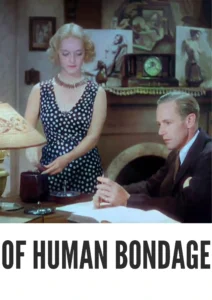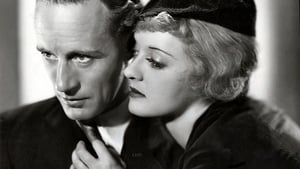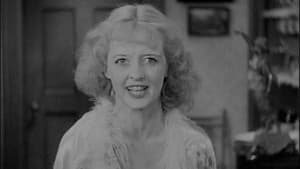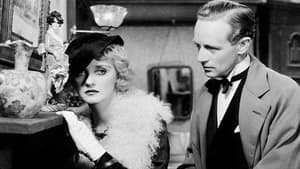Video Sources 0 Views
- Watch trailer
- Of Human Bondage 1934 Colorized


Synopsis
Table of Contents
TogglePassion, Art, and Obsession: Of Human Bondage (1934) in Stunning Color

Step into the tumultuous world of Philip Carey with Of Human Bondage, a powerful drama from 1934, now beautifully colorized for a captivating viewing experience. Starring Leslie Howard and Bette Davis, this film explores themes of love, obsession, and the search for meaning in a beautifully rendered cinematic classic. Perfect for fans of classic cinema and those who appreciate deeply emotional storytelling, this HD download brings a timeless story to life like never before.
Of Human Bondage Storyline: A Journey of Self-Discovery
Of Human Bondage tells the story of Philip Carey (Leslie Howard), a sensitive andClub foot young man who feels trapped by his circumstances. He initially pursues art in Paris but soon realizes he lacks the talent to succeed. Returning to England, Philip becomes a medical student, hoping to find purpose and direction in his life.His world is turned upside down when he meets Mildred Rogers (Bette Davis), a waitress with whom he becomes infatuated. Despite her cruel and manipulative nature, Philip becomes obsessed with Mildred, leading to a destructive and heartbreaking relationship. Throughout the film, Philip struggles with his feelings for Mildred, his ambitions, and his own sense of self-worth. He endures numerous hardships, including financial struggles and personal losses, as he attempts to break free from the bonds that hold him captive. Ultimately, Of Human Bondage is a poignant and moving story about the complexities of human relationships and the search for personal fulfillment.
Movie Cast
The film features stellar performances from its cast:
- Leslie Howard as Philip Carey
- Bette Davis as Mildred Rogers
- Frances Dee as Sally Athelny
- Reginald Denny as Harry Griffiths
- Alan Hale as Emil Miller
Movie Genre
Of Human Bondage is a drama that explores themes of romance and obsession. Its complex characters and emotional depth make it a compelling and thought-provoking film.
Historical Context: A Pre-Code Masterpiece
Released in 1934, Of Human Bondage is considered a pre-Code film, meaning it was produced before the strict enforcement of the Motion Picture Production Code. This allowed the film to explore more mature and controversial themes than would have been possible in later years. The film was based on the semi-autobiographical novel of the same name by W. Somerset Maugham, which was published in 1915. The novel was considered groundbreaking for its frank portrayal of human emotions and relationships. Of Human Bondage remains a significant work of early Hollywood cinema, showcasing the talents of its cast and crew and its willingness to tackle complex and challenging subject matter.
Colorization Details
This colorized version of Of Human Bondage has been meticulously restored using modern digital techniques, enhancing the visual appeal while preserving the film’s original atmosphere. The colorization process involved carefully analyzing the grayscale tones of the original black and white footage and assigning appropriate colors to each scene. While the specific software used remains proprietary, the techniques employed included advanced algorithms for color palette selection and image enhancement. This painstaking process brings new life to the characters and settings, making the story even more engaging for modern audiences. While some may debate the merits of colorizing classic films, it introduces these films to a broader audience, ensuring their legacy for future generations.
Technical Details
- Director: John Cromwell
- Screenplay: Lester Cohen
- Based on: the novel by W. Somerset Maugham
- Cinematography: Henry W. Cronjager
- Edited by: William Hamilton
- Production Company: RKO Radio Pictures
- Distributed by: RKO Radio Pictures
- Runtime: 83 minutes
Technical Specifications
- Download Format: MP4
- Resolution: HD (1080p)
- Compatibility: Compatible with most devices, including smartphones, tablets, computers, and smart TVs.
Reviews and Critical Reception
Of Human Bondage (1934) is highly regarded for its powerful performances and its unflinching exploration of human emotions. Bette Davis’s portrayal of Mildred Rogers is considered one of the greatest performances of her career. The film was a critical and commercial success upon its release and has since become a classic of American cinema. Its themes of love, obsession, and self-discovery continue to resonate with audiences today.
FAQs
- Q: What is Of Human Bondage about?
- A: Of Human Bondage is a drama about a young man’s tumultuous relationship with a manipulative woman and his search for meaning in life.
- Q: Is Of Human Bondage (1934) a pre-Code film?
- A: Yes, Of Human Bondage was released before the strict enforcement of the Motion Picture Production Code, allowing it to explore more mature themes.
- Q: Is this version of Of Human Bondage colorized?
- A: Yes, this version has been professionally colorized to enhance the viewing experience.
- Q: What makes Of Human Bondage a classic film?
- A: Of Human Bondage is a classic film due to its powerful performances, its exploration of complex themes, and its historical significance as a pre-Code production.
- Q: What is the download format?
- A: The download format is MP4, which is compatible with most devices.
- Q: What resolution is the download?
- A: The resolution is HD (1080p), providing a high-quality viewing experience.
Download Now in HD!
Watch Of Human Bondage Today!














